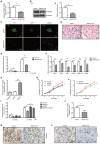Long non-coding RNA SNHG17 enhances the aggressiveness of C4-2 human prostate cancer cells in association with β-catenin signaling
- PMID: 33907582
- PMCID: PMC8063240
- DOI: 10.3892/ol.2021.12733
Long non-coding RNA SNHG17 enhances the aggressiveness of C4-2 human prostate cancer cells in association with β-catenin signaling
Abstract
Long non-coding (lnc) RNAs have emerged as important regulators of cancer development and progression. Several lncRNAs have been reported to be associated with prostate cancer (PCa); however, the involvement of lncRNA SNHG17 in PCa remains unclear. In the present study, the mRNA expression level of SNHG17 in 58 pairs of PCa tumor samples and adjacent non-tumor tissues, as well as in PCa tumor cell lines was analyzed. The regulatory effect of SNHG17 on the oncogenic phenotypes of the C4-2 tumor cell line was also investigated. The clinicopathological analysis revealed that SNHG17 mRNA expression level was increased in the PCa tumor samples, and its high expression levels were associated with poor patient outcomes, indicating that SNHG17 may act as a biomarker for the prognosis of PCa. SNHG17 mRNA expression level was also increased in different PCa tumor cell lines. Functionally, SNHG17 increased C4-2 tumor cell growth and aggressiveness by stimulating tumor cell proliferation, survival, invasion and resistance to chemotherapy. Furthermore, SNHG17 promoted in vivo tumor growth in a xenograft mouse model. Notably, the SNHG17-induced in vitro and in vivo oncogenic effects were associated with activation of the β-catenin pathway. The results from the present study revealed that lncRNA SNHG17 could be an important regulator in the oncogenic properties of human PCa and may; therefore, represent a potential PCa therapeutic target.
Keywords: SNHG17; Wnt; lncRNA; prostate cancer.
Copyright: © Zhao et al.
Conflict of interest statement
The authors declare that they have no competing interests.
Figures





Similar articles
-
Long noncoding RNA SNHG17: a novel molecule in human cancers.Cancer Cell Int. 2022 Mar 5;22(1):104. doi: 10.1186/s12935-022-02529-7. Cancer Cell Int. 2022. PMID: 35248073 Free PMC article. Review.
-
Enabling factor for cancer hallmark acquisition: Small nucleolar RNA host gene 17.Front Oncol. 2022 Sep 14;12:974939. doi: 10.3389/fonc.2022.974939. eCollection 2022. Front Oncol. 2022. PMID: 36185210 Free PMC article. Review.
-
Long Non-coding RNA SNHG17 Promotes Cell Proliferation and Invasion in Castration-Resistant Prostate Cancer by Targeting the miR-144/CD51 Axis.Front Genet. 2020 Apr 15;11:274. doi: 10.3389/fgene.2020.00274. eCollection 2020. Front Genet. 2020. PMID: 32351538 Free PMC article.
-
Long non-coding RNA SNHG17 is an unfavourable prognostic factor and promotes cell proliferation by epigenetically silencing P57 in colorectal cancer.Mol Biosyst. 2017 Oct 24;13(11):2350-2361. doi: 10.1039/c7mb00280g. Mol Biosyst. 2017. PMID: 28933484
-
LncRNA SNHG17 interacts with LRPPRC to stabilize c-Myc protein and promote G1/S transition and cell proliferation.Cell Death Dis. 2021 Oct 20;12(11):970. doi: 10.1038/s41419-021-04238-x. Cell Death Dis. 2021. PMID: 34671012 Free PMC article.
Cited by
-
Long noncoding RNA SNHG17: a novel molecule in human cancers.Cancer Cell Int. 2022 Mar 5;22(1):104. doi: 10.1186/s12935-022-02529-7. Cancer Cell Int. 2022. PMID: 35248073 Free PMC article. Review.
-
Integrative Analysis and Experimental Validation Indicated That SNHG17 Is a Prognostic Marker in Prostate Cancer and a Modulator of the Tumor Microenvironment via a Competitive Endogenous RNA Regulatory Network.Oxid Med Cell Longev. 2022 Jul 12;2022:1747604. doi: 10.1155/2022/1747604. eCollection 2022. Oxid Med Cell Longev. 2022. PMID: 35864871 Free PMC article.
-
Unlocking the role of non-coding RNAs in prostate cancer progression: exploring the interplay with the Wnt signaling pathway.Front Pharmacol. 2023 Sep 27;14:1269233. doi: 10.3389/fphar.2023.1269233. eCollection 2023. Front Pharmacol. 2023. PMID: 37829301 Free PMC article. Review.
-
Enabling factor for cancer hallmark acquisition: Small nucleolar RNA host gene 17.Front Oncol. 2022 Sep 14;12:974939. doi: 10.3389/fonc.2022.974939. eCollection 2022. Front Oncol. 2022. PMID: 36185210 Free PMC article. Review.
-
VIM‑AS1 promotes proliferation and drives enzalutamide resistance in prostate cancer via IGF2BP2‑mediated HMGCS1 mRNA stabilization.Int J Oncol. 2023 Mar;62(3):34. doi: 10.3892/ijo.2023.5482. Epub 2023 Feb 3. Int J Oncol. 2023. PMID: 36734275 Free PMC article.
References
-
- Global Burden of Disease Cancer Collaboration. Fitzmaurice C, Allen C, Barber RM, Barregard L, Bhutta ZA, Brenner H, Dicker DJ, Chimed-Orchir O, Dandona R, et al. Global, regional, and national cancer incidence, mortality, years of life lost, years lived with disability, and disability-adjusted life-years for 32 cancer groups, 1990 to 2015: A systematic analysis for the global burden of disease study. JAMA Oncol. 2017;3:524–548. doi: 10.1001/jamaoncol.2016.5688. - DOI - PMC - PubMed
LinkOut - more resources
Full Text Sources
Other Literature Sources
Miscellaneous
